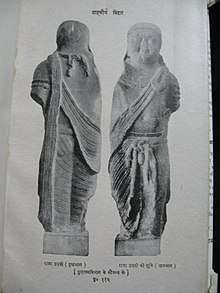Udayin

| Udayin | |
|---|---|
| Ruler of Magadha | |
| Reign | c. 460 – c. 444 BCE |
| Predecessor | Ajatashatru |
| Successor | Anuruddha |
| Died | 444 BC |
| Dynasty | possibly Haryanka |
| Father | Ajatashatru |
Udayin (r. c. 460-444 BC) was a king of Magadha in present-day India. According to the Buddhist and Jain accounts, he was the son and successor of the Haryanka king Ajatashatru. Udayin laid the foundation of the city of Pataliputra at the confluence of two rivers, the Son and the Ganges. He shifted his capital from Rajgriha to Patliputra due to the latter's central location in the empire.
Ancestry
According to the Buddhist accounts, the successors of the Magadha ruler Bimbisara were Ajatashatru, Udayabhadda (Udayin), Anuruddha, Munda and Nagadasaka.[1] The Jain tradition also mentions Udayin as the son and successor of Ajatashatru.[2] However, the Puranas name the successors of Bimbisara as Ajatashatru, Darshaka, Udayin, Nandivardhana and Mahanandin.[1] The Matsya Purana names Vamsaka as the successor of Ajatashatru.[3] Since the Puranas were composed at a later date, the Buddhist tradition seems to be more reliable.[1] The Nagadasaka of the Buddhist chronicles is identified with the "Darshaka" of the Puranas.[4]
Professor H. C. Seth (1941) identified Udayin with the king Udayana mentioned in the Sanskrit play Svapnavasavadatta.[3] The Chinese traveler Xuanzang states that the last descendant of Bimbisara built a sangharama (monastery) at Tiladaka. Seth theorized that this last descendant was Darshaka, and Udayin established a new dynasty, as signified by his transfer of the empire's capital from Rajgriha to Pataliputra.[5] Liladhar B. Keny (1943) criticized Seth's theory as incorrect. According to him, the Udayana of Svapnavasavadatta was a different king, who ruled Vatsa kingdom with his capital at Kaushambi.[3]
R. G. Bhandarkar notes that the name of Darshaka (Dasaka) is prefixed with the word "Naga" in the Buddhist chornicles, which may signify his detachment to his successors and his attachment to the Nagas of Padmavati . This implies that he may be from a different family and had become the king approximately three generations after Ajatashatru, not immediately succeeding him.[6]
Early life
The Buddhist traditions state that Udayin was Ajatashatru's favourite son, and was alive during the reign of his grandfather Bimbisara. When Ajatashatru met Gautama Buddha, Udayin was a young prince.[4]
Reign
Udayin ruled during c. 460-444 BC.[7] His reign is best noted for the foundation of the Pataliputra city at the confluence of the Son and the Ganges rivers. His father had built a fort here to repulse a potential Pradyota invasion from Avanti. Udayin moved his capital to Pataliputra, probably because it was at the centre of his growing kingdom.[2]
Successors
The Puranas mention Nandivardhana as the successor of Udayin. However, the Sri Lankan Buddhist chronicles state that he was succeeded by Anuruddha. These Buddhist chronicles also state that all the kings from Ajatashatru to Nagadasaka, including Udayin, killed their fathers.[2]
References
- 1 2 3 Liladhar B. Keny 1943, p. 61.
- 1 2 3 V. K. Agnihotri, ed. (2010). Indian History. Allied Publishers. p. A-168. ISBN 978-81-8424-568-4.
- 1 2 3 Liladhar B. Keny 1943, p. 63.
- 1 2 Liladhar B. Keny 1943, p. 62.
- ↑ Liladhar B. Keny 1943, pp. 61-64.
- ↑ Bhandarkar, Devadatta Ramkrishna (1918). "Lectures on the ancient history of India, on the period from 650 to 325 B. C." University of Calcutta. pp. 71–72.
- ↑ R.S. Sharma (2006). India's Ancient Past. Oxford University Press India. p. 158. ISBN 978-0-19-908786-0.
Bibliography
- Liladhar B. Keny (1943). "The supposed identification of Udayana of Kauśāmbi with Udayin of Magadha" (PDF). Annals of the Bhandarkar Oriental Research Institute. Bhandarkar Oriental Research Institute. 24 (1/2): 60–66.
| Regnal titles | ||
|---|---|---|
| Preceded by Ajatashatru |
King of Magadha c. 460–444 BC |
Succeeded by Anuruddha |